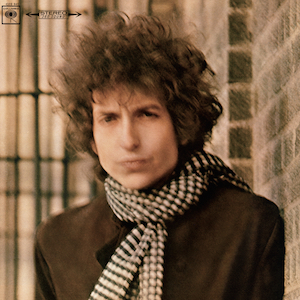
Bob Dylan – Blonde on Blonde
Alright, gather ’round, you jingle-jangle morning chasers and poetic puzzle enthusiasts. We’re about to dive into the lyrical labyrinth that is Bob Dylan’s “Blonde on Blonde.” This isn’t just an album; it’s a Rosetta Stone for decoding the human condition, wrapped in a double LP that’s as thick as a Midwestern accent and twice as intriguing.
Released in 1966, “Blonde on Blonde” hit the scene like a surrealist painting come to life, stumbling out of a smoky Greenwich Village cafĂ© and into the mainstream. It’s as if Dylan took the English language, put it in a tumbler with some amphetamines and beat poetry, then poured out pure, distilled genius.
Let’s start with “Rainy Day Women #12 & 35,” shall we? This carnival of chaos kicks off the album like a drunken marching band crashing a funeral. With its woozy brass and Dylan’s gleeful proclamation that “Everybody must get stoned,” it’s either a coded drug reference or the world’s most rollicking Old Testament allusion. Either way, it sets the tone for an album that’s about as straightforward as a corkscrew.
“Visions of Johanna” slithers in next, a seven-minute fever dream that’s denser than a neutron star and just as likely to warp your perception of reality. Dylan’s stream-of-consciousness lyrics paint a picture so vivid yet so abstract, it’s like trying to describe a Dali painting to a blind man while high on laughing gas. “The ghost of electricity howls in the bones of her face”? I mean, come on! That’s not songwriting; that’s linguistic alchemy.
“I Want You” provides a brief respite of relatively straightforward desire, though in Dylan’s hands, even a love song becomes a kaleidoscopic journey through want and need. It’s catchy enough to be pop, but weird enough to remind you that you’re still in Dylan’s funhouse mirror world.
But let’s talk about “Stuck Inside of Mobile with the Memphis Blues Again.” This track is a parade of characters so colorful, they make Sgt. Pepper’s Lonely Hearts Club Band look like a bunch of accountants on casual Friday. It’s a song that manages to be both nonsensical and profound, like overhearing a philosophical debate in a madhouse.
And then there’s “Sad Eyed Lady of the Lowlands,” the epic 11-minute closer that takes up an entire side of vinyl. It’s a love song, a riddle, and a fever dream all rolled into one. By the time Dylan’s done spinning his web of imagery, you’ll feel like you’ve just read a Russian novel backwards while riding a merry-go-round.
Producer Bob Johnston deserves a medal for herding these musical cats into some semblance of an album. The sound is as mercurial as Dylan’s lyrics, shifting from raucous blues to tender balladry with the ease of a chameleon changing colors.
“Blonde on Blonde” isn’t just an album; it’s a Rorschach test in musical form. It’s the sound of the 1960s counter-culture distilled into a potent brew of folk, rock, blues, and pure, uncut Dylan. It’s an album that doesn’t just reward repeated listens; it demands them, revealing new layers of meaning with each spin.
In conclusion, “Blonde on Blonde” is like that weird dream you had after falling asleep reading Allen Ginsberg while a blues record played in the background. It’s confusing, exhilarating, and utterly captivating. It’s not just music; it’s a full-body experience that’ll leave your mind buzzing and your dictionary weeping.
So, should you listen to “Blonde on Blonde”? Does a one-legged duck swim in circles? Of course you should! Just don’t expect to understand it all on the first… or fiftieth listen. This album isn’t a quick fix; it’s a lifelong companion that’ll keep you company on rainy days, sunny days, and those strange, in-between days when reality seems just a bit off-kilter. Kind of like Bob himself.